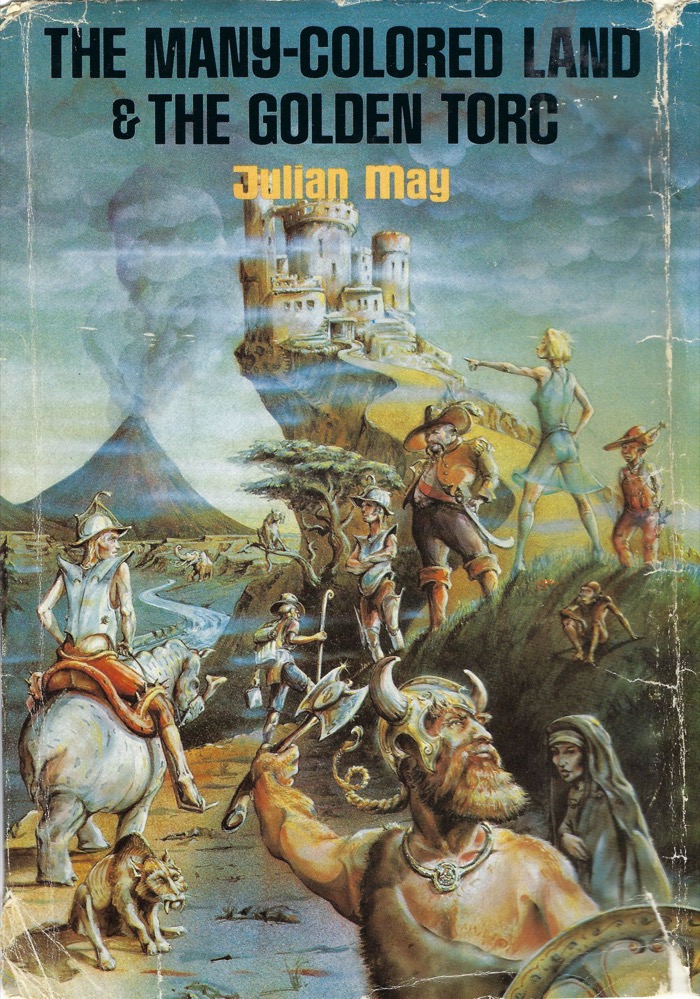The Many-Colored Land
Reviewed date: 2017 Sep 8
Rating: 3
387 pages
It's the 22nd century, and humanity has developed metapsychic powers, spread out among the stars, met alien races, and discovered time travel. Ah, but the time travel has a catch: it only works at one specific location in rural France, the destination is fixed to an interval of six million years, and it's a one-way trip. Still, a small but steady stream of adventurers, misfits, and seekers take the trip to make a new life for themselves in the savage Pliocene Epoch.
Ragtag Band of Merry Misfits
The first third of The Many-Colored Land is interminable. We get introduced in boring detail to eight different people and their boring reasons for choosing to leave the Galactic Milieu and exile themselves to the Pliocene.
- Elizabeth, who once had metapsychic powers of healing, but lost them in a skiing accident.
- Aiken Drum, a troublemaking scoundrel who chose Pliocene Exile over capital punishment or imprisonment.
- Felice, a young psychopathic Joan of Arc.
- Richard Voorhees, a bad boy starship captain.
- Bryan, an anthropologist chasing a schoolboy crush into the Pliocene.
- Stein, a driller or something. Violent, and I'm not sure why he chose the Pliocene.
- Amerie: a jaded, burned-out nun.
- Claude, a widowed palaeontologist who chooses the Pliocene after his wife passes away.
Faerie Overlords and Golden Torcs
The Pliocene is a savage world, but in an unexpected twist, the savagery comes not from Pliocene beasts, but from honest-to-goodness alien overlords. The Pliocene is ruled by the Tanu, alien refugees from a faraway galaxy who crashlanded on Earth and enslaved the locals. The Tanu use golden torcs that unlock their latent metapsychic powers. The Tanu also provide torcs to their human slaves. The torcs unlock any latent metapsychic powers the humans possess, but the torcs are also fitted with control circuits, giving the Tanu complete power over their slaves.
In addition to enslaving humans who come through the time portal, the Tanu also use the temporally indigenous ramapithecines as common laborers: fitted with gray torcs, the ramas are intelligent enough to carry out simple physical labor and household chores.
The Tanu are only half of the equation, though. A sister race, the Firvulag, came with them. Where the Tanu are like powerful faerie lords wielding their torc-given mental skills, the Firvulag are faerie tricksters, ugly evil creatures inhabiting the dark forests and using natural metapsychic powers (no torcs needed) to cast illusions and spells. It's seelie faerie vs unseelie faerie. In fact, that's precisely the model the author is using: these Tanu and Firvulag are the progenitors of the faerie myths.
Blood-metal and Photon Cannons
Once the stage has been set (again, tediously), the final third of the book gives us an exciting battle. Felice and several others escape the Tanu and help organize a resistance. They recruit the Firvulag, hoping that a surprise attack with a combined army can destroy the Tanu torc-making facility. Without torcs, the Tanu will be unable to maintain their dominance.
The resistance has two secret weapons. First, they've discovered that iron is deadly to the Tanu. You can stick a Tanu with bronze weapons until she looks like a pincushion, and she'll recover; prick her with a iron blade and her heart will stop. The humans arm themselves with iron-tipped arrows, swords, and spears.
The second weapon is more advanced. Felice and several others locate the wrecked spacecraft that brought the Tanu and Firvulag to Earth, and recover a weapon: a portable photon cannon. With the photon lance, iron weapons, and the metapsychic disguises of the Firvulag to enable them to creep up on the Tanu defenses, the rag-tag band of humanity and faerie strike a grave first blow against the Tanu.
If the first two-thirds of the book could be condensed into two chapters, this would be a great book. As it is, there are too many characters, too much meandering and worldbuilding and not enough story. I found it a chore to read.
